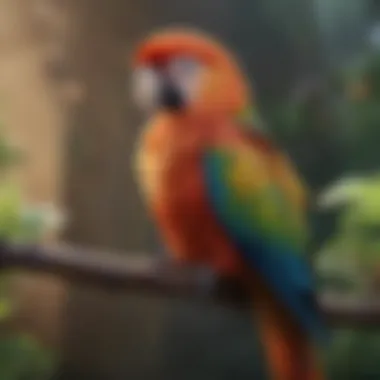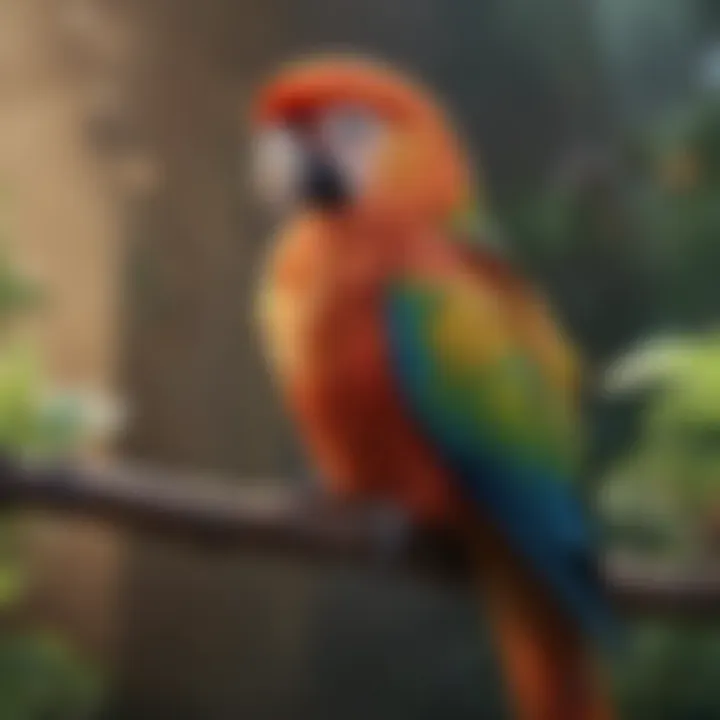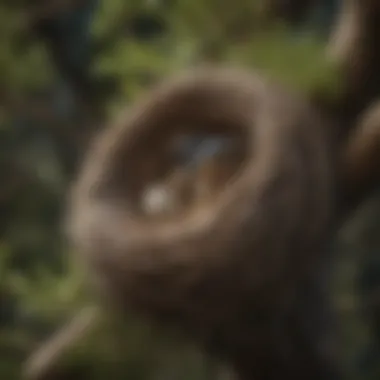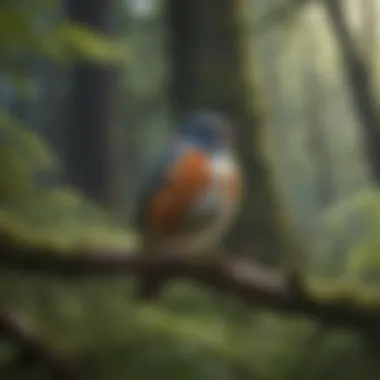Fascinating Aspects of Bird Life and Behavior


Intro
Birds are fascinating creatures, with their myriad colors, unique behaviors, and complex social interactions. From the chirping in your backyard to the spectacular migrations of swans, the avian world is rich with wonder. However, many aspects of bird life remain obscured by a veil of common knowledge. This article pulls back that curtain, diving into the intricate details of avian existence.
In the following sections, we’ll explore a range of topics that highlight the remarkable features of birds, from their evolutionary adaptations to the roles they play in our ecosystems. Whether you are a seasoned bird watcher, an aspiring bird parent, or simply curious about these winged wonders, you will find insights that deepen your appreciation for them.
We'll delve into their daily care, behavioral nuances, nutrition essentials, health maintenance, and enriching activities that can promote their overall well-being. Each subsection aims to provide clarity and guidance, forming a comprehensive understanding that benefits both birds and their caretakers. So, buckle up as we embark on this enlightening journey into the world of avian existence.
Unique Characteristics of Birds
Understanding the unique characteristics of birds shines a light on the fascinating diversity present within this class of animals. The features that define birds—such as their physical traits, adaptations, and behaviors—are not merely for show; they play critical roles in their survival and success. Knowing these intricacies helps enthusiasts and casual observers alike appreciate how these creatures thrive in various environments.
Diversity in Size and Form
Birds come in all shapes and sizes, from the diminutive hummingbird to the towering ostrich. This size variation isn't just a product of chance but is deeply connected to ecological niches. For instance, a large bird is often better suited for life on the ground, while smaller birds can exploit different resources in trees or shrubs.
Different forms serve diverse purposes. Think of the sleek body of a falcon, an energy-efficient design for high-speed flight, versus the squat shape of a penguin, optimized for agility both in water and on ice. The adaptability in size and form among bird species speaks volumes about their evolutionary success. Each bird's unique structure is a direct response to environmental forces and resource availability, reinforcing survival.
Distinctive Feather Structures
Feathers are not just for decoration; they're fundamental to a bird's lifestyle. They provide insulation, aid in flight, and in many cases, are a canvas for communication. The flamboyant plumage of a peacock is not merely eye-catching; it plays a role in mate selection, where brighter feathers may signify better health.
Different birds also have feather types best suited for their particular needs. For example, water birds possess waterproof feathers that keep them buoyant, while some desert birds have downy feathers that help regulate body temperature. This feather diversity illustrates how birds adapt to their environments, showcasing their evolutionary innovations.
The Role of Beaks
A bird's beak can be likened to a versatile tool, crafted by nature for a multitude of tasks. From the long, narrow beak of a hummingbird, ideal for sipping nectar, to the powerful, curved beak of a hawk, used for tearing flesh, the variety is astounding. Each shape and size plays a crucial role in a bird's feeding habits and ecological role.
An interesting observation is how beak adaptations reflect the available food sources in their habitats. For example, finches that feed on seeds have stronger, thicker beaks, while insectivorous birds possess slender beaks for prying insects out of tight spots. These characteristics are not random; they represent millions of years of adaptation.
"The diversity among birds is a testament to nature's creativity and the adaptability of life."
Evolutionary Adaptations
Understanding the concept of evolutionary adaptations is crucial when examining the existence of birds. These adaptations have enabled avian species to thrive in diverse environments around the globe. Each change over time has been driven by various factors, such as climate, availability of food, and predation pressures. It's not merely about survival; these adaptations highlight the remarkable ingenuity found in nature.
The beauty of evolutionary adaptations lies in their specificity. For instance, consider how the structure of a bird's body has evolved to optimize its ability to fly. Thinner bones, unique muscle arrangements, and specialized wing shapes all contribute significantly to aerodynamic efficiency. These features have allowed birds to conquer the skies and exploit ecological niches unavailable to other animals.
Several considerations regarding evolutionary adaptations stand out:
- Niche Differentiation: Different species have adapted to occupy specific ecological niches. For example, the woodpecker has developed a unique hammering behavior and specialized beak structure to access the insects hidden within tree bark.
- Reproductive Strategies: Birds like the emu or penguin exhibit differing mating rituals and parental care systems. Such variations ensure that the next generation inherits traits vital for their environment.
- Behavioral Flexibility: Certain birds, such as the parrots, display a high degree of intelligence, allowing them to solve complex problems that may arise due to changing circumstances.
These adaptations demonstrate that evolutionary processes are ongoing and can influence future generations.
Flight Mechanisms
The mechanisms of flight in birds highlight an intricate interplay of anatomy and physics. The evolution of wings—from gliding ancestors to the active flapping we observe today—speaks volumes about environmental pressures faced by different species.
Birds like the albatross have developed long, narrow wings for dynamic soaring, which allows them to glide vast distances over open ocean without expending much energy. In contrast, the hummingbird has evolved to hover in one spot, employing rapid wing beats that exceed 80 times per second. This ability allows it to access nectar from flowers that remain out of reach for most other species.
"Flight is not just a mode of travel for birds; it is a key survival strategy that has shaped their evolution and ecological roles."
Camouflage and Mimicry
Camouflage and mimicry serve as fascinating adaptive strategies that birds employ for survival. Birds like the common snipe exploit their surroundings by blending seamlessly into marshy landscapes, a clever tactic to evade both predators and hunters. Their mottled feathers work like nature's very own paintbrush, rendering them nearly invisible among reeds and grasses.
Mimicry extends beyond mere appearance; some birds, such as the lyrebird, are capable of imitating sounds from their environment, including other bird calls or even human-made noises. This behavior not only aids in attracting mates but can also confuse potential threats.
In addition to camouflage and mimicry, here are a few other aspects that enhance the understanding of these adaptations:
- Seasonal Changes: Many birds will change plumage coloration depending on the season, aligning their appearance with environmental variables.
- Behavior in Social Groups: For example, rooks often gather in large numbers, which can create auditory confusion for predators, thereby increasing their safety.
Behavioral Adaptations
Behavioral adaptations are equally significant when considering avian survival. These adaptations include migration, foraging strategies, and social behaviors that various species exhibit. Birds like the Arctic tern, renowned for undertaking the longest migration route of any animal—over 70,000 kilometers each year—illustrate the impact of resource availability and seasonal weather changes on behavior.
Additionally, consider the feeding habits of the African Grey Parrot. This species has developed complex problem-solving skills to acquire food, showcasing a high level of intelligence that rivals that of some primates. Likewise, cooperative breeding among birds, like that seen in some species of wrens, where individuals assist in raising young not their own, indicates advanced social structures within avian communities.
In summary, the evolutionary adaptations of birds embody a story of resilience and ingenuity. From flight mechanics to camouflage and beyond, these traits form a rich tapestry that illustrates how birds have adapted to their environments over countless generations, and they challenge us to appreciate the intricate details of their existence.
Communication Among Avian Species
Understanding how birds communicate is a fascinating aspect of their existence. Bird communication encompasses a range of forms including vocal sounds, body language, and social interactions. These methods are essential for survival, facilitating everything from mating rituals to warning others of predators.
Vocalizations and Their Meanings
Birds are well-known for their vocal abilities. Each species has its own unique set of calls and songs. These vocalizations carry different meanings and serve various purposes. For instance, a male robin may sing to attract a mate, while another call warns of danger.


- Types of Sounds:
- Songs: Usually melodious and often more complex, primarily used during mating season or to establish territory.
- Calls: Generally shorter and used for communication among flock members.
Understanding these vocalizations can deepen the appreciation of avian life. A well-timed chirp can indicate excitement, while a series of quick notes might suggest distress. Enthusiasts often report that learning specific calls enhances their experience in the wild.
Visual Signals
Beyond sound, birds also communicate through visual signals. This includes posturing, feather displays, and even movement patterns. A bird fluffing its feathers might be showcasing itself, while a head tilt can express curiosity or aggression.
- Notable Visual Cues:
- Courtship Displays: During mating season, many species exhibit elaborate dances or displays to woo potential mates.
- Body Language: The positioning of wings, tails, or even bill display can convey messages of readiness or unease.
Birds also use color as a form of communication. Brightly colored plumage in males often signals health and vitality, crucial for attracting mates.
Social Interactions and Group Behaviors
Birds are inherently social creatures. Their interaction within flocks has significant implications for survival and reproduction. Group behaviors allow for more effective foraging, help in evading predators, and facilitate breeding opportunities.
- Importance of Social Bonds:
- Cooperative Breeding: Some species, like the Florida Scrub-Jay, display communal care, meaning young from previous broods assist in raising new chicks.
- Flocking Behavior: By flying in groups, birds create a collective defense against predators. This behavior, often seen in starlings, showcases the dynamic interaction among individuals.
In essence, the complexity of communication among birds is remarkable and serves as a testament to their adaptation and survival strategies. Learning about these behaviors can also foster a deeper connection between pet bird owners and their feathered friends, making each chirp in the morning feel just a little more meaningful.
"The language of birds is rich tapestry woven with sound, color, and behavior. Understanding this can transform the way we see these creatures."
For more insights delve into resources like Wikipedia or Britannica.
Migration Patterns
Migration is not just a remarkable aspect of avian life; it’s a survival strategy that ensures species persist amidst environmental changes. As seasons shift, birds embark on journeys that span thousands of miles, driven by instinct and necessity. These patterns are intricately woven into the fabric of both their biological makeup and the ecosystems they inhabit. Understanding migration patterns provides essential insights into the health of bird populations, their adaptive behaviors, and the broader impact of changing climates on wildlife.
Long-Distance Travelers
Among the most awe-inspiring feats of nature, long-distance migratory birds traverse vast spaces, often without faltering. For example, consider the Arctic Tern. This small bird holds the record for the longest migration, traveling approximately 71,000 kilometers from its breeding grounds in the Arctic to wintering areas in the Antarctic. This annual trek underscores the tern's specialized adaptations, such as a lightweight body structure and robust wings, which enable sustained flight.
Other notable long-distance migrators include:
- Gray-headed Albatross: This bird can fly for days without flapping its wings, soaring with productivity across the Southern Ocean.
- Swallow-tailed Kite: A champion of soaring, its ability to glide allows it to cover expansive distances in search of food.
Navigational Skills
Birds possess incredible navigational skills, often compared to the best GPS systems. They rely on a variety of techniques to find their way. Many of these birds can detect the Earth's magnetic field, using it as a compass. Others utilize the position of the sun during the day or the stars at night to guide their flight path.
An intriguing example is the Wood Warbler, which has been shown to navigate by using geographical features, such as rivers and coastlines. Moreover, some studies suggest that certain species possess a visual awareness of the magnetic fields of the Earth. This multi-faceted ability to navigate showcases the complexity of avian biology, a finely-tuned system that ensures survival through seasonal migrations.
**"Birds have developed remarkable adaptations that allow them to carry out their migrations with precision and efficiency, highlighting the connection between their biology and their environment."
Impact of Climate Change on Migration
As much as migratory patterns have evolved, current shifts in climate are pressing birds to adapt rapidly. Changes in temperature affect food availability, nesting sites, and migratory schedules. Species such as the Red Knot demonstrate altered migration patterns, resulting in mismatched timing with food sources like the horseshoe crab eggs critical for their survival during migration.
Additionally, habitats along migration routes are increasingly fragmented due to urbanization and agricultural expansion, which further complicates successful passage and nesting. A notable example is the decline in the populations of migratory songbirds, which are now facing harsher conditions than ever before.
Key considerations regarding climate change and bird migration include:
- Altered migration timing, disrupting breeding and food availability.
- Increased competition for resources along migratory routes.
- Potential extinction of vulnerable migratory species due to habitat loss and climate factors.
The future of bird populations lies in adaptive measures both taken by the birds and those enacted by conservationists to protect their environments. Understanding these migration patterns is critical in addressing the challenges posed by climate change and ensuring that avian species continue to thrive.
Social Structures in Bird Communities
Understanding social structures in bird communities is pivotal for several reasons. Birds are social creatures, and their interactions often dictate both individual and species success. Social structures impact everything from mating strategies to survival tactics. By recognizing the nuances of these structures, bird enthusiasts and breeders can foster better environments for their pets or breeding programs.
Flocking Behavior
Flocking behaviors are a fascinating component of avian life. When birds flock together, they enhance their chances of survival. This is not just about safety in numbers; it also contributes to foraging efficiency and navigation. Birds like starlings, for instance, create spectacular murmurations - large, fluid formations that can confuse predators.
These group dynamics also facilitate learning and adaptation. Youthful birds often observe and mimic older, more experienced flocks, acquiring vital skills like finding food or avoiding dangers. From a breeding perspective, understanding flocking behavior can provide valuable insights into the socialization of young birds, enabling breeders to create environments that mimic natural flock interactions.
Breeding Practices
Breeding practices in bird communities are oftentimes intricate and heavily influenced by social structures. Many species engage in elaborate courtship displays, utilizing songs and visual signals to attract mates. These behaviors not only establish pair bonds but also signify genetic fitness, which is crucial for the survival of the species.
An important aspect of breeding is the concept of cooperative breeding, where multiple individuals assist in raising the young. For example, in species like the African grey parrot, such cooperation can increase the survival rate of chicks. This mutualistic approach not only bolsters the community but also enriches the social fabric among birds, fostering a culture of support that breeders can learn from when managing offspring in captivity.


Territoriality and Defense Mechanisms
Territoriality is a key survival strategy among many bird species. It involves claiming and defending a specific area against intruders, which can be critical during the breeding season. Males often exhibit aggression towards rivals to secure breeding rights, employing calls, displays, and sometimes physical confrontations. Understanding these behaviors helps pet bird owners and breeders create environments where territorial instincts can be appropriately managed.
Defense mechanisms can vary widely among species. For example, the American robin employs a mixture of vocal threats and physical showdowns to defend its nest. On the other hand, some smaller species, like the goldfinch, may rely on more covert strategies like camouflage and quick escapes. By recognizing these behaviors, enthusiasts can better appreciate their birds' natural instincts and create their habitats accordingly.
"The social structures of birds reveal much about their adaptability and survival strategies in the wild. By understanding these delicate dynamics, we can better care for our avian companions."
In summary, exploring social structures in bird communities reveals much about their survival and social strategies. By delving into flocking behavior, breeding practices, and territoriality, bird lovers can gain essential knowledge that deepens their connection to these remarkable creatures.
Feeding Habits and Nutrition
Understanding the feeding habits and nutrition of birds is essential for appreciating their roles in ecosystems and for those who care for them as pets. Birds have fascinating dietary preferences and adaptations that reflect their evolutionary pathways. By exploring these aspects, we gain insights not just into their health and survival, but also into their interactions with the environment.
Dietary Preferences Across Species
Birds exhibit an incredible range of dietary preferences, shaped by their biology and habitat. For instance, some species, like the American Robin, primarily consume insects and fruits, while others, such as the Great Horned Owl, are carnivorous hunters. In contrast, the humble sparrow often opts for seeds and grains.. This dietary diversity is a response to environmental availability, forging an intricate balance in their ecosystems.
- Insectivores: Depend on insects, aiding in pest control.
- Herbivores: Favor seeds, fruits, and nectar, supporting plant propagation.
- Carnivores: Hunt small mammals and birds, maintaining population controls in ecosystems.
- Omnivores: Combine both plant and animal sources, offering flexibility.
It’s intriguing to watch how these preferences influence a bird's behavior. For example, during the breeding season, some species will switch their diet, favoring high-protein sources to support their young.
Adaptations for Food Acquisition
Birds have evolved numerous adaptations tailored for food acquisition, marking a unique intersection of anatomy and behavior. Their beak shapes are a prime example of this evolutionary feature. The curved beak of the hummingbird, designed for nectar extraction, contrasts sharply with the sharp, hooked beak of a hawk, which is built for tearing flesh.
Additionally, some birds have mastered the art of tool use. The New Caledonian Crow is known for creating tools from branches to extract insects from tree bark. This innovation showcases their cognitive abilities tied closely to their survival instincts.
Examples of Adaptations:
- Bill Shapes: Finches possess various bill sizes for cracking different seeds.
- Tongue Structures: Woodpeckers have long tongues to extend deep into tree trunks.
- Foraging Techniques: Various bird species use different strategies—while some might peck at the ground, others, like the heron, patiently wait and strike for fish.
The Importance of Nutrient Diversity
Nutritional diversity is not merely beneficial but essential for avian health as it supports their metabolic needs. A diet lacking in variety can lead to malnutrition, which in turn impacts reproduction, feather development, and immune function.
“A diverse diet is as crucial for birds as it is for humans.”
Different birds need different nutrients. For instance, calcium is vital for laying females, affecting eggshell quality. Likewise, antioxidants from native fruits can bolster a bird’s immunity and prolong its lifespan.
- Vitamins and Minerals: Play roles in feather growth and energy conversion.
- Omega Fatty Acids: Essential for brain and feather health.
- Fiber: Aids in digestion, particularly for seed-eating birds.
In summary, the feeding habits and nutrition of birds reflect not only their adaptability but also their place in the ecosystem, influencing everything from breeding patterns to population dynamics. For pet owners and breeders, understanding these facets is crucial, so they can provide diets that not only meet the basic needs but also promote overall well-being.
For further exploration into bird diets and nutrition, check sources such as Britannica for detailed articles and studies.
Human Impact on Bird Populations
In the grand tapestry of nature, birds play a vital role. They influence ecosystems, contribute to pollination, and facilitate seed dispersal. However, their populations are facing mounting pressures from human activities. Understanding how human actions affect birds is crucial not only for their survival but also for maintaining the health of our planet. This section delves into various ways in which humans impact bird populations, emphasizing the critical need for awareness and action.
Habitat Loss and Its Consequences
One of the most significant threats to avian populations is habitat loss. Urbanization, deforestation, and agricultural expansion lead to vast swathes of natural habitat being destroyed. As forests are cleared for agriculture or housing, birds lose their nesting sites, foraging grounds, and migratory routes. The consequences of such loss are dire:
- Reduction in Population Sizes: Many bird species are sensitive to changes in their habitats. When these areas are compromised, their populations often decline.
- Loss of Biodiversity: Habitat destruction can drive some species to extinction, which affects the overall biodiversity and health of ecosystems.
- Disruption of Migration Patterns: Birds that rely on specific routes may find themselves unable to navigate or locate safe havens, leading to increased mortality.
The impact extends beyond just individual species; it creates ripples through entire ecosystems. More than just feathered creatures, birds are indicators of environmental health. When they struggle, it's a warning for us.
Conservation Efforts and Strategies
Recognizing the importance of preserving avian populations has spurred numerous conservation efforts around the globe. Various organizations, both large and small, are spearheading initiatives aimed at protecting bird habitats and ensuring their survival. Some notable efforts include:
- Habitat Restoration Projects: Rehabilitating damaged ecosystems can help restore areas where birds can thrive. Initiatives may involve reforesting, wetland restoration, or creating protected areas.
- Bird-Safe Urban Planning: Many cities are adopting bird-friendly architectural practices, such as using bird-safe glass and creating green spaces that support local wildlife.
- Public Education Campaigns: Raising awareness about the importance of birds and their habitats encourages community involvement in conservation efforts. Programs aimed at school-aged children often have long-lasting effects, fostering a future generation of bird advocates.
As these strategies evolve, it's essential for individuals—especially pet bird owners and aspiring bird parents—to participate. Their influence can amplify initiatives through simple actions, such as creating bird-friendly gardens or advocating for protective measures in their communities.
The Role of Legislation in Bird Protection
Legislative measures play a pivotal role in the conservation of bird populations. Laws and regulations can create frameworks for protecting endangered species, managing hunting practices, and safeguarding habitats. Among the most important pieces of legislation are:
- The Migratory Bird Treaty Act: This treaty, enacted in 1918, affords protection to many migratory bird species in North America. It serves as a critical tool in preventing hunting, capture, and destruction of nests.
- The Endangered Species Act: Enacted in 1973, this law aims to protect species that are at risk of extinction and their habitats.
"Legislation isn't just red tape; it's a lifeline for species teetering on the brink."
These laws foster collaboration among governments, conservation groups, and the public. They set baselines for conservation efforts while empowering communities to take active roles in the protection of their local avian populations.
Cultural Significance of Birds


Birds hold a significant place across various cultures around the globe. From ancient civilizations to modern societies, these creatures have been emblems of divine messages, omens, and symbols of freedom. This cultural significance reveals not just a fascination with their beauty but also an understanding of their roles in ecosystems and in the daily lives of people. For many, birds embody deeper philosophical concepts and cultural narratives, showcasing the intersection of nature and humanity in a rich tapestry of symbolism and artistry.
Symbolism in Various Cultures
In countless cultures, birds are often linked to spiritual themes and messages. For instance, in ancient Egypt, the ibis was associated with Thoth, the god of writing and wisdom, while the hawk represented royal power. In Native American traditions, the eagle is seen as a sacred being, embodying strength and courage, often used in rituals to represent divine guidance.
Moreover, the dove is universally regarded as a symbol of peace and purity. The colors and characteristics of birds often carry specific meanings depending on the context and local beliefs, depicting a deep connection that people feel towards the avian realms.
Birds in Literature and Art
Throughout history, birds have found a fertile ground in art and literature. Their beauty and grace often serve as inspiration for countless poets, writers, and artists. For instance, Emily Dickinson famously wrote about the resilience of birds, often using them as metaphors for human emotion and experience. Similarly, in art, the swallow has appeared in paintings symbolizing hope and renewal.
In various artworks, the depiction of birds can evoke a sense of longing or nostalgia, reminding us of the transient nature of life. Their representations in culture are not merely ornamental—they carry narratives that resonate with human experiences throughout the ages.
Folklore and Mythology Involving Birds
Birds have been central characters in folklore and mythology, serving as messengers and heralds of change. For example, in Greek mythology, the owl is synonymous with Athena, the goddess of wisdom, representing knowledge and foresight.
Similarly, in many Asian traditions, the phoenix symbolizes rebirth and immortality, embodying the idea of transformation through fire. Such narratives highlight birds as symbols that navigate the realms between the earthly and the divine.
"Birds remind us of aspiration, hope, and the desire to transcend our limitations."
This profound connection to mythology and folklore showcases why understanding the cultural significance of birds enriches our appreciation of them, encouraging us to look beyond their physical presence and consider their symbolic weight in our lives.
- Birds in various cultural contexts unveil a larger narrative of human connection to nature.
- Their symbolism and representation in art mirror the societies that cherish and respect them.
- Folklore intertwines human values and ideals with the avian world, enhancing our understanding of both.
In summary, the cultural significance of birds extends beyond their beauty; it encapsulates humanity’s hopes, fears, and aspirations, making them a timeless subject of examination and admiration.
Innovative Adaptations in Urban Environments
Understanding how birds adapt to urban environments is crucial, especially now when more natural habitats vanish. Urban areas can be starkly different from the wilderness birds usually roam. Examining these adaptations sheds light on survival strategies, resourcefulness, and the relationship between avian species and the environments we create. This section looks at specific urban bird species, their nest building techniques, and the resource utilization strategies they employ in cities.
Urban Bird Species
Cities have become home to various bird species that have gotten savvy about their surroundings. Some common urban dwellers include the European Starling, House Sparrow, and Rock Pigeon. These birds have figured out how to thrive amidst concrete and asphalt, capitalizing on the food sources and infrastructure we provide.
- European Starling: Known for its glossy black feathers, this bird is often seen in flocks, scavenging for discarded food, making them remarkably adaptable.
- House Sparrow: Friendly and familiar, these birds build nests in almost any crevice, from eaves to public signs, showcasing their penchant for making the most of available spaces.
- Rock Pigeon: Originally cliff-dwellers, these birds have translated their natural habitats to urban buildings, where ledges mimic their ancestral nesting sites.
Nest Building in Cities
Nest building in urban environments presents unique challenges and opportunities. Urban birds have become ingenious in finding suitable spots to lay their eggs. Many species make the best of man-made structures, turning gutters, window sills, and air conditioning units into ideal nesting spaces.
For example, the House Sparrow often nestles itself into the overhangs of buildings or behind signage. The proximity to humans offers a variety of foraging options, thus maximizing the survival chances of their young. Here are the nesting materials frequently used:
- Twigs and grass
- Paper and plastic pieces
- Feathers and fur
Utilizing these materials not only showcases an impressive level of creativity but also hints at the ecological flexibility birds possess. With the right mix of resourcefulness and adaptability, urban birds continue to thrive.
Resource Utilization in Urban Areas
Resourcefulness doesn't end at nest building. Urban birds have learned to source food efficiently, adapting their diets to include urban offerings. Birds often forage in parks, sidewalks, and various commercial areas where food scraps abound. This change in behavior highlights both the versatility of their diets and their adaptation to urban life.
Some notable points about their resource utilization include:
- Scavenging: Pigeons and sparrows often feast on trash leftover by humans, demonstrating their ability to find food where it's least expected.
- Gardens and Parks: Urban gardens provide berries and seeds, making them hotspots for various species looking for nourishment.
- Feeding Stations: People often put out bird feeders, intentionally drawing in species like cardinals and finches.
"Birds have shown us that survival in a man-made world is not just about adapting but thriving amid change."
In sum, the innovative adaptations in urban environments speak volumes about the resilience of birds. Their ability to merge into urban landscapes, utilizing what we often overlook, gives us insight into their remarkable adaptability. As pet bird owners, aspiring bird parents, or bird breeders, understanding these behaviors enriches our awareness of avian life, encouraging us to appreciate the complexities of these winged inhabitants.
The Future of Avian Research
The exploration of avian species is not merely an academic pursuit; it's essential for understanding broader ecological dynamics. As we look ahead, the future of bird research stands to benefit from technological advancements, interdisciplinary studies, and robust public engagement. Researchers are increasingly aware of how birds can serve as indicators of environmental health, influencing conservation efforts that can make a lasting impact.
Advancements in Tracking Technologies
As bird enthusiasts, we know that tracking a bird's journey can be as thrilling as watching them soar through the sky. Modern technology has ushered in significant innovations in tracking methods. GPS collars, satellite tags, and even lightweight geolocators allow researchers to monitor the movements of birds like never before.
- Precision: Technologies now provide real-time data, showcasing the migratory routes of species like the Arctic Tern.
- Minimization: New tools are lighter and less invasive, ensuring birds are not hindered in their natural behaviors.
- Data Accumulation: The volumes of data generated give insights into migratory patterns, breeding grounds, and habitat use.
These advancements are not just academic. They enable scientists to understand how birds adapt to changing climates and human encroachment, informing conservation strategies at a grassroots level.
Interdisciplinary Approaches to Bird Studies
Birds exist at the intersection of several scientific disciplines, making interdisciplinary research crucial. Combining ecology, technology, sociology, and psychology leads to richer understanding and varied perspectives on avian life. For example:
- Ecologists study the impact of environmental change on bird populations.
- Sociologists examine how cultural attitudes affect bird conservation efforts.
- Psychologists delve into the cognitive abilities of birds, influencing how we perceive their intelligence and social structures.
By bridging these areas, researchers can adopt comprehensive strategies that address the complexities of avian existence.
"When we unify various scientific lenses, we not only deepen our knowledge of birds but cultivate a sense of stewardship among the public."
Citizen Science and Public Engagement
Here's where it gets exciting: the role of everyday people in advancing avian research cannot be underestimated. Citizen science has become a crucial component in data collection and public awareness. Bird enthusiasts and casual observers alike can contribute valuable data through initiatives like the Great Backyard Bird Count.
Benefits of citizen engagement include:
- Increased Data Collection: Volunteers help gather data from diverse geographic locations.
- Education: Participating in citizen science teaches individuals about avian species and the importance of biodiversity.
- Community Building: This fosters a sense of community among bird lovers while promoting conservation efforts.
The future of avian research is bright, and it offers every bird lover an opportunity to play a role. By embracing technology, interconnecting various fields, and involving the public, we inch closer to a more profound understanding of the avian world.















